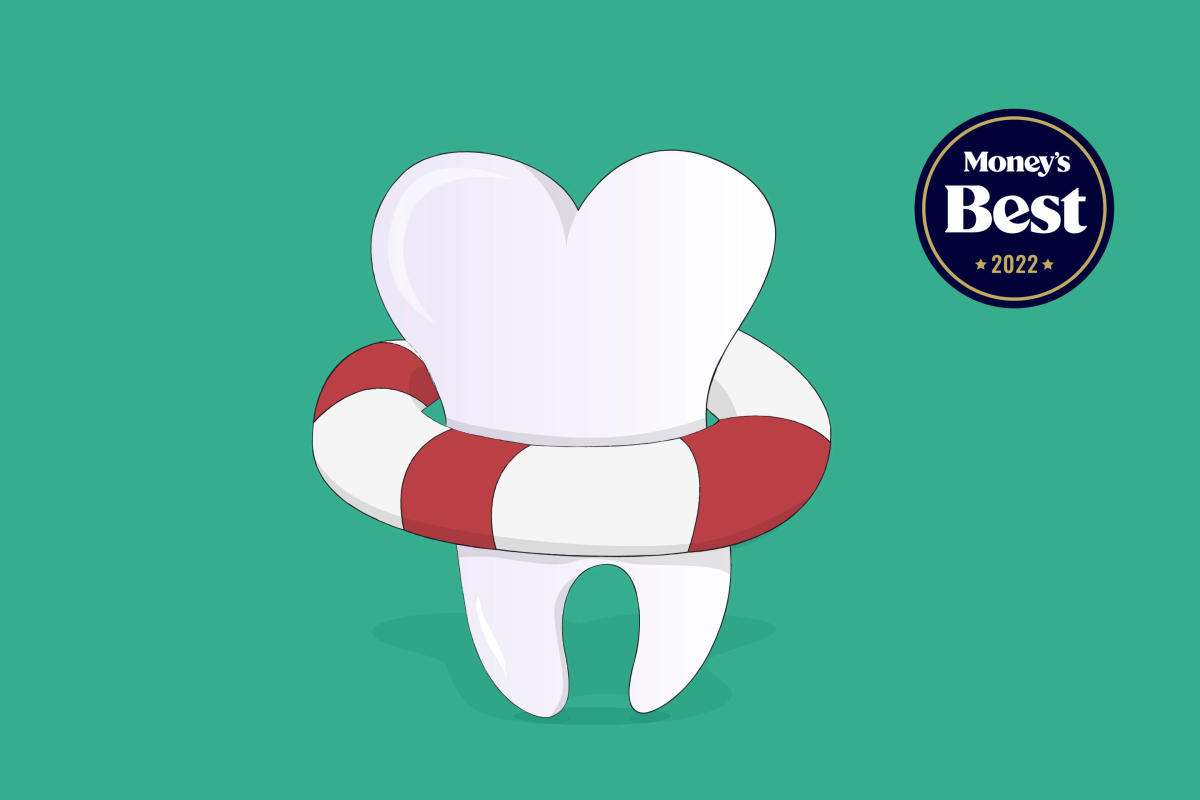Personal Finance
7 Best Dental Insurance Plans

Our Partners
Top Partner
Our Partner
Get a Free Quote
-
No waiting periods on preventive, basic, and major services
-
Guaranteed acceptance
-
PPO plans to choose your own dentist
-
Implants and major services covered
-
A+ BBB accredited
-
30-day money back guarantee
-
No price increase for age
-
Lifetime $100 deductible
-
Option to bundle vision
Our Partner
Get a Free Quote
-
Unlimited Use
-
Pre-Existing Conditions Included in Plan Savings
-
Plans Start at $99/Year for Discounted Rates on Dental Procedures
-
100,000+ Dental Access Points Nationwide
-
A+ Grade with the BBB
-
Voted #1 in Ethics by Dallas Morning News
-
Discount Dental Plan (Not Insurance)
Our Partner
Get a Free Quote
-
Connect with over 100,000 dentists nationwide
-
30+ Dental Savings Plans to Choose from
-
No annual limits for dental savings plans
-
30 day Refund Policy
-
Detailed dental saving reports for each procedure
-
10-60% off Dental Procedures including (cleanings, X-rays, dentures, root canals, fillings and even braces!)
-
New users get 10% off ANY plan and 2-Month FREE! Use promo code: ADVOCATE
A stand-alone dental plan may be the best way to keep up with your oral health if your insurance doesn’t cover dental treatment. Without insurance, the cost of routine dental care (cleanings and X-rays) generally runs from $40 to $97, while more complex procedures like a root canal may cost over $1,000 per tooth.
Depending on the type coverage and your dental care needs, an individual policy can prove to be very expensive — especially when you factor in deductibles, copays and premiums. However, dental insurance can lower the cost of expensive restorative or emergency work such as crowns, fillings and implants.
The best providers offer a high reimbursement limit, comprehensive coverage and shorter or no waiting periods for basic care. Check out the list below for the best dental insurance plans.
Our Top Picks for Best Dental Insurance Plans
-
Guardian Direct – Best for Major Work
-
Delta Dental – Best for Braces
-
Humana – Best for Variety of Plan Options
-
DentaQuest – Best for Affordable Premiums
-
Spirit Dental – Best for No Waiting Periods
-
United HealthCare Dental – Best for Short Waiting Periods on Major Work
-
Cigna – Best for Nationwide Coverage
Best Dental Insurance Reviews
Pros
-
Low NAIC complaint index
-
No waiting period for fillings and simple extractions in 37 states
-
All plans cover 50% of dentures and implants
Cons
-
Ranks below industry average in J.D Power’s 2022 Dental Plan Satisfaction Study
-
No orthodontic coverage for adults
-
DHMO plans are only available through employer-provided insurance
Why we chose it: Guardian Direct stands out because it includes 50% major dental work coverage on every plan type except the Starter (its preventive-only plan.)
Guardian Direct‘s Core plan covers procedures such as crowns, oral surgery, implants and dentures. Annual maximum limits start at $500 and go up to $1,000 by year three, while dental implants have a separate lifetime maximum of $700.
The middle tier, the Achiever plan, adds orthodontic benefits for people under 19 years of age and increases the annual maximum limits. The plan starts with a $1,000 limit and goes up to $1,500 by the third year.
Finally, the Diamond plan starts with a maximum payout limit of $1,500 for the first year, and adds coverage for teeth whitening (capped at $500 annually).
HIGHLIGHTS
- Network size
- States available
- Waiting periods
|
Plan type |
Monthly premium for Miami, Florida (33101) |
Monthly premium for Los Angeles, California (90001) |
Monthly premium for New York City (10001) |
|
Starter |
Unavailable |
$24.00 |
$23.26 |
|
Core |
$24.09 |
$31.99 |
$31.01 |
|
Achiever |
$34.47 |
$46.56 |
$45.14 |
|
Diamond |
$43.29 |
$58.48 |
$56.69 |
Pros
-
Low NAIC complaint index
-
Available on state and federal exchanges (marketplaces)
-
Premium and HMO plan cover braces for adults and children
Cons
-
Available plans vary significantly per state
-
HMO plan doesn’t cover dental implants
Why we chose it: Delta Dental’s nationwide availability, comprehensive dental benefits and no upper age limit for braces make it an excellent choice for families and individuals in need of orthodontic care.
Delta Dental is one of the few providers that extends orthodontic benefits to children and adults. Sample quotes from California, Florida and New York returned three plan options, two of which include orthodontic coverage.
-
Delta PPO Premium covers 100% of routine care and 20 to 50% of basic and major procedures. Orthodontic treatment has 50% coverage, up to a $1,500 lifetime maximum.
-
DeltaCareUSA (HMO) sets fixed copayment rates for preventive, basic and major services (including orthodontia) without deductibles or annual limits. The downsides are that policyholders must pay an upfront annual premium and the provider network is limited.
Readers interested in Delta Dental should note that, although Delta lists a total of five dental plans on its main website, the benefits and availability of each plan differ per zip code.
To see which plans are available to you, select your state from the company’s drop down menu, which includes all 50 states and Puerto Rico.
HIGHLIGHTS
- Network size
- States available
- Waiting periods
|
Plan type |
Monthly premium for Miami, Florida (33101) |
Monthly premium for Los Angeles, California (90001) |
Monthly premium for New York City (10001) |
|
Delta Dental PPO Individual–Basic Plan |
$21.57 |
$29.08 |
$24.24 |
|
Delta Dental PPO Individual–Premium Plan |
$48.79 |
$64.92 |
$48.48 |
|
DeltaCare USA* |
$8.92 ($107.04 per year) |
$8.92 ($107.04 per year) |
$20.58 ($246.96 per year) |
*Made in one single payment for the whole year.
Pros
-
Low-cost preventive plan option
-
One plan with no waiting periods on preventive, basic and major care
-
Ranks 1st in J.D. Power 2022 U.S Dental Plan Satisfaction Study
Cons
-
High NAIC complaint index in a lot of its state subsidiaries
-
No coverage for implants
-
No coverage for orthodontic care
Why we chose it: Humana offers seven dental plans. There are five plans that cover in-network and out-of-network dentists, a dental savings plan and a low-cost HMO plan with a limited provider network.
Humana dental’s plan options start with five policies that cover in-network and out-of-network dental care:
-
Preventive Value PPO works for people looking for preventive care at a low cost
-
The Bright Plus PPO plan adds coverage for basic procedures such as fillings and simple extractions and includes veteran discounts for prescriptions and vision and hearing care.
-
The last two policies, Complete Dental PPO and Loyalty Plus PPO, provide the most comprehensive coverage with benefits for preventive, basic and major procedures.
We particularly liked the Loyalty Plus PPO plan because there are no waiting periods on any covered benefit, including major work. The downside is that the plan sets a high deductible ($150) and policyholders have to wait until the third year of enrollment to get the highest annual limit allowable ($1,500).
Humana also offers a dental savings plan and a Dental Value HMO plan. Dental Value HMO covers preventive, basic and major procedures without waiting periods, deductibles, or annual limits. This policy works best for people who prefer affordable premiums and don’t mind a limited provider network or fixed copayment fees.
HIGHLIGHTS
- Network size
- States available
- Waiting periods
|
Plan type |
Monthly premium for Miami, Florida (33101) |
Monthly premium for Los Angeles, California (90001) |
Monthly premium for New York City (10001) |
|
Dental Value (HMO) |
$11.99 |
Unavailable |
Unavailable |
|
Preventive Value PPO |
$19.49 |
$21.99 |
$18.99 |
|
Bright Plus for Veterans PPO |
$23.99 |
$26.54 |
$21.36 |
|
Bright Plus PPO |
$23.99 |
$26.54 |
$21.36 |
|
Loyalty Plus PPO |
$35.99 |
$46.99 |
Unavailable |
|
Complete Dental |
$57.99 |
$59.99 |
$59.99 |
|
Dental Savings Plus |
$6.99 |
Unavailable |
$7.99 |
Pros
-
Affordable options for preventive, basic and major care starting at $8.35
-
Orthodontic coverage for children and adults
-
Ranks third in J.D Power’s 2022 U.S. Dental Plan Satisfaction Study
Cons
-
One plan enforces 18-month waiting period on major work
-
No out-of-network coverage
Why we chose it: For under $15 a month, DentaQuest’s Personal Dental Plus covers 100% of preventive services, 50% of basic care and 30% of major procedures.
DentaQuest offers preventive-only and comprehensive dental care at a significantly lower price than its competitors.
-
Personal Dental Plan covers preventive care (annual cleanings, X-rays and evaluations)
-
The following plan tiers — Personal Dental Plan Basic and Personal Dental Plus — add more coverage for minor and major restorative services such as extractions, fillings, denture repairs and oral surgery.
DentaQuest adds orthodontic benefits to its major work coverage with the following policies:
-
Personal Dental Plan Comprehensive Ortho 15000 covers 100% preventive, 80% basic and 50% major work up to an annual benefit limit of $1,500
-
Personal Dental Plan Comprehensive Ortho 2000 covers 100% preventive, 80% basic and 50% major work up to an annual benefit limit of $2,000
As with other providers, plan availability varies by state. Enter your zip code on DentaQuest’s search tool to see the plan options in your area.
HIGHLIGHTS
- Network size
- States available
- Waiting periods
|
Plan type |
Monthly premium for Miami, Florida (33101) |
Monthly premium for Atlanta, Georgia (30301) |
Monthly premium for Houston, Texas (77001) |
|
Personal Dental Plan |
$8.35 |
$12.42 |
$14.93 |
|
Personal Dental Plan Basic |
$12.28 |
$19.77 |
$20.31 |
|
Personal Dental Plan Plus |
$14.21 |
$22.90 |
$22.38 |
|
Personal Dental Plan Comprehensive with Orthodontia 1500 |
Unavailable |
$44.43 |
Unavailable |
|
Personal Dental Plan Comprehensive with Orthodontia 2000 |
Unavailable |
$34.55 |
Unavailable |
*Sample quotes for DentaQuest’s personal dental plans aren’t available in New York or California.
Pros
-
No waiting periods on any plan
-
Plan option with $5,000 annual maximum limit
-
Covers three dental cleanings per year
Cons
-
Expensive premium rates
-
No coverage for adult orthodontia
-
No HMO plans available
Why we chose it: Spirit Dental is one of the few providers that waive waiting periods on all its dental policies and across all benefit categories, including major and restorative work.
Spirit Dental’s plan options are split into two groups:
-
Network plans offer the best rates with in-network providers
-
Choice plans allow beneficiaries to pick their preferred provider with no network requirements. However, this flexibility comes at the expense of higher premiums and out-of-pocket costs.
Two of Spirit Dental’s plans — Pinnacle Choice and Pinnacle Network — also offer a calendar year annual maximum of up to $5,000 (except in Connecticut, Illinois and New York). This benefit is a significant jump from the usual limit of $1,500, which is a big relief for policyholders who need to finance major procedures such as implants or dentures. However, beneficiaries must pay high premium rates and wait until year three of enrollment to qualify for the full $5,000.
Feel free to download Spirit Dental’s brochure for more details about coverage benefits in specific states.
HIGHLIGHTS
- Network size
- States available
- Waiting periods
|
Plan type |
Monthly premium for Miami, Florida (33101) |
Monthly premium for Los Angeles, California (90001) |
Monthly premium for New York City (10001) |
|
Secure Network |
$29.82 |
$28.75 |
Unavailable |
|
Core Network |
$37.46 |
$37.95 |
$54.45 – $63.27 |
|
Pinnacle Network |
$47.23 |
$46.79 |
Unavailable |
|
Senior Preferred |
$54.00 |
$55.43 |
Unavailable |
|
Secure Choice |
$45.33 |
$44.52 |
Unavailable |
|
Core Choice |
$56.74 |
$58.58 |
Unavailable |
|
Pinnacle Choice |
$75.70 |
$76.40 |
Unavailable |
|
Senior Preferred Choice |
$85.47 |
$89.40 |
Unavailable |
Pros
-
Multiple plan options with a range of prices
-
6-month waiting period on major work
-
Ranks second in J.D. Power’s 2022 U.S. Dental Plan Satisfaction Study
Cons
-
No orthodontic coverage for adults
-
Above average NAIC complaint index
Why we chose it: While most providers enforce a 12-month waiting period for major work such as crowns, bridges and oral surgery, UnitedHealthOne has three plans with a waiting period of six months.
Dental plans with no waiting periods can be prohibitively expensive for many people. If you can’t afford to wait a long time, the next best option is to look for a plan with a shorter waiting period.
United HealthOne’s Premier Elite, Primary Preferred and Primary Preferred Plus plans offer a six-month waiting period to meet the needs of patients who can’t wait the standard 12 months for procedures such as crowns, bridges and dentures.
Out of the three plans mentioned, Premier Elite offers the highest coinsurance for major services (60%) as well as a $2,000 annual payout limit. Here’s what Premier Elite coverage looks like:
-
Preventive coverage – 100% coverage for routine cleanings and exams from day one
-
Basic coverage – Includes fillings and extractions. The policy covers 50% from day one up to $2,000 annually. Coverage will increase to 80% by year two.
-
Major work coverage – 15% coverage after six months; 50% by year one; 80% coverage by year two.
In addition to the Premier Elite plan, UnitedHealthOne offers an additional seven dental insurance policies divided into Primary and Premier plans. The Premier category includes policies with no waiting periods, high annual payout limits and high coinsurance for major dental care, while Primary policies offer comprehensive benefits at lower premium rates and better coverage for out-of-network providers.
HIGHLIGHTS
- Network size
- States available
- Waiting periods
|
Plan type |
Monthly premium for Miami, Florida (33101) |
Monthly premium for Los Angeles, California (90001) |
|
Primary Dental |
$30.68 |
$31.34 |
|
Primary Preferred Dental |
$46.05 |
$47.03 |
|
Primary Plus Dental |
$46.40 |
$43.59 |
|
Primary Preferred Plus Dental |
$67.71 |
$63.62 |
|
Premier Choice Dental |
$48.75 |
$59.37 |
|
Premier Elite Dental |
$54.81 |
$66.74 |
|
Premier Plus Dental |
$56.67 |
$69.04 |
|
Premier Max Dental |
$59.15 |
$72.06 |
Pros
-
Competitive benefits for preventive, basic and major care
-
15% discount for each for eligible dependents added to the policy.
-
Ranks fourth in J.D. Power’s 2022 U.S. Dental Plan Satisfaction Study
Cons
-
No coverage for implants
-
High NAIC complaint index in some states
Why we chose it: Cigna’s availability combined with a provider network of over 92,700 dentists in more than 309,000 locations make it our top choice for nationwide coverage.
Cigna offers its beneficiaries in all 50 states two dental insurance plans with preventive, basic and major care coverage, and one preventive coverage policy:
-
Cigna Dental Preventive — covers 100% of preventive care. No deductible or annual limits apply.
-
Cigna Dental 1000 — covers 100% of preventive care, 80% of basic services and 50% of major work. The payout limit is set at $1,000 per calendar year.
-
Cigna Dental 1500 — covers 100% of preventive care, 80% of basic services and 50% of major work. The annual limit is set at $1,500 and covers orthodontia for children and adults up to $1,000 per lifetime.
Lastly, older adults and retirees who’ve lost employer-provided coverage and those looking to switch out their insurance can get immediate dental care with Cigna. Provided the policyholder had dental insurance in the past 12 months, Cigna will waive all waiting periods on restorative care such as cavity fillings and root canals.
HIGHLIGHTS
- Network size
- States available
- Waiting periods
|
Plan type |
Monthly premium for Miami, Florida (33101) |
Monthly premium for Los Angeles, California (90001) |
Monthly premium for New York City (10001) |
|
Cigna Dental Preventive |
$21.00 |
$25.00 |
$25.00 |
|
Cigna Dental 1000 |
$34.00 |
$40.00 |
$40.00 |
|
Cigna Dental 1500 |
$41.00 |
$47.00 |
$47.00 |
Other dental insurance plans we considered
The following companies didn’t meet the requirements for any of our “Best for” categories, including dental insurance marketplaces and discount plans. That said, they’re still worthy of consideration, especially for readers who may want an alternative to traditional dental insurance or the convenience of purchasing insurance through a marketplace.
1Dental
1Dental offers a different way to pay for dental care through its dental discount membership program. The company negotiates discounted rates with participating providers and passes these savings onto its members.
1Dental offers two membership plans for a yearly fee of $119 or a bundle of both for $169. Because these aren’t traditional dental plans, there are no waiting periods, exclusions, annual limits, or deductibles.
Pros
-
No deductibles, waiting periods, or annual limits
-
30-day money-back guarantee
-
Orthodontic discounts apply to children and adults
Cons
-
Plans are dental discount memberships, not dental insurance
-
All payments are out-of-pocket
-
Membership fees start at $119
DentalPlans.com
DentalPlans.com is a marketplace where you can find both dental discount plans and dental insurance. Once you provide your zip code, the platform lists various dental plan options from providers such as Aetna, Humana, Delta and Renaissance Dental.
Dental savings plans purchased through DentalPlans.com are eligible for a 30-day money-back guarantee. That said, the marketplace charges a $20 enrollment fee that’s non-refundable.
Pros
-
Marketplace for dental savings plans and dental insurance
-
Users can search and compare different plans
-
Dental savings plans are activated within three days
Cons
-
Not dental insurance
-
$20 enrollment fee
Physicians Mutual
Physicians Mutual’s dental plans cover over 400 preventive, basic and major dental procedures at the provider of your choice. What sets each plan apart is the monthly premium rate and the dollar amount that’s reimbursed to the policyholder for each eligible service.
Standard waiting periods apply to basic and major dental services, but there are no annual maximum limits, no deductibles and no network requirements.
Pros
-
No deductibles or payout limits
-
30-day satisfaction guarantee
-
Direct deposit reimbursements
Cons
-
No 100% coverage on preventive care
-
No orthodontic coverage
Dental Insurance Guide
In this section, we explain how dental plans work and the insurance options available on the market. We also discuss the costs associated with dental care and the steps you should take to choose the right dental insurance provider.
How does dental insurance work?
A dental insurance policy covers expenses for checkups, routine cleanings and other dental restorative work such as fillings, implants and crowns. Many providers such as Humana, Cigna and UnitedHealthOne also offer dental, hearing and vision bundles.
Providers are regulated at the state level, meaning plan availability, benefits and rates may vary per state.
What does dental insurance cover?
Insurance carriers divide dental insurance coverage into three categories: preventive care, basic or routine care and major procedures.
-
Preventive care includes checkups (oral exams and cleanings), sealants and X-rays. Most providers offer 100% coverage with no waiting periods and deductibles for these procedures.
-
Basic or routine care refers to fillings, non-routine X-rays, denture repairs and simple extractions. Coverage is generally capped at 80% and beneficiaries must meet the policy’s deductible rate.
-
Major procedures include root canals, gum disease, surgical extractions, dentures and implants. Coverage rarely exceeds 50% after meeting the policy’s deductible.
Although it’s technically major work, orthopedic treatment is considered a separate category for insurers. It’s easier to find coverage for child orthodontia than for adults, but coverage is capped at 50% regardless of the patient’s age.
Companies also enforce a lifetime benefit limit, meaning they will only pay for braces or aligners once for the duration of the policy.
If you are considering braces, take a look at our article on how much Invisalign costs and the choices available.
Dental coverage exclusions
Dental insurance includes pre-existing conditions clauses like congenitally missing teeth. This means your plan won’t pay for implants or bridges to replace missing teeth unless those teeth are missing due to an accident or illness.
Waiting periods
Once you have an active policy, insurers may enforce a waiting period on certain services. Although this ultimately depends on the plan type and company, standard waiting periods look a bit like this:
-
Preventive services: 0 months
-
Basic procedures: 3 to 6 months
-
Major services: 12 to 24 months
Dental plans without waiting periods on basic and major services exist, but they’re expensive. Coverage also starts small and increases yearly. For example, implants are immediately covered, but the company will only pay 15% of the total cost, which is very little considering that a single implant can cost over $1,600. The company will pay 50% of the same procedure if a patient waits six months or more.
Types of dental insurance plans
The three types of dental plans on the market today are dental preferred provider organization (DPPO or PPO) plans, dental health maintenance organization (DHMO or HMO) plans and fee-for-service plans:
Dental preferred provider organization (DPPO)
DPPO plans have a wider network of dentists, and patients have more flexibility when choosing their doctors. You can see providers both in-network and out of network, but you’ll find the best rates within the dental provider network.
This flexibility comes with a higher price tag — premiums for DPPO plans are more expensive and have higher out-of-pocket costs.
Dental health maintenance organization (DHMO)
A DHMO plan works within a dental provider network. There’s a fixed copayment for each visit, premiums are more affordable and there are no annual maximum limits.
Members of a DHMO plan have a smaller provider network to choose from, and they’ll also need to select a primary care dentist from the plan’s network. Lastly, there’s no coverage for out-of-network providers, and seeing a specialist requires a referral.
Fee-for-service plans
Fee-for-service plans pay a flat rate for eligible services. This plan type allows greater flexibility because patients can visit the provider of their choice.
On the downside, out-of-pocket expenses are higher. Patients can either make a copayment at the dentist’s office or pay upfront and then file a claim for reimbursement with their insurance provider.
Dental discount plans
A dental discount plan is not dental insurance. It’s a membership program that charges a monthly or annual fee in exchange for discounts on eligible dental services of participating providers.
There are no waiting periods on any services, and most procedures benefit from a discounted rate — even orthodontics. With dental discount plans, uninsured individuals can still access dental care at a reduced cost. However, discount rates vary from 10% to 60% and the network of participating dentists may be smaller.
Besides dental discount plans or preventive coverage, you can invest in additional products to brush up on your dental hygiene. Devices like electric toothbrushes and water flossers help keep cavities and gum disease at bay.
How much is dental insurance?
Dental plan premiums range from $17 to $96. Cost varies per plan type, coverage level and state of residence.
The plans with the lowest premiums cover preventive dental care and offer minimal or no coverage for basic and major services. On the other hand, the plans with the highest premiums tend to have shorter or no waiting periods, high annual limits and comprehensive coverage for preventive, basic and major work.
If purchasing a dental insurance plan doesn’t make sense for your financial situation, consider low-cost alternatives to dental health insurance such as dental school clinics and state assistance programs.
Cost of common dental procedures
The cost of dental care depends significantly on the provider, the location and whether the patient’s insured.
To give readers a general idea, we looked at the average cost of common dental procedures in the 2020 Survey of Dental Fees published by the American Dental Association (ADA). Then, we calculated how much that procedure would cost with an insurance policy that covers 100% of preventive care, 80% of basic dental work and 50% of complex procedures.
Here’s what we found:
|
Cost without dental insurance |
Cost with dental insurance |
|
|
X-rays |
$40 – $143 |
$0 |
|
Cleanings |
$73 – $97 |
$0 |
|
Dental filling |
$171 – $471 |
$34 – $94 |
|
Root canal |
$369 – $1,325 |
$184 – $662 |
|
Dental crown |
$528 – 1,386 |
$264 – $693 |
Additional costs to consider
Policyholders pay monthly premiums for their coverage, but that’s not the only expense to keep in mind. Deductibles, copayment, coinsurance and annual maximum limits also affect the total cost of dental care.
Deductibles
A deductible is the amount you pay before your insurance coverage kicks in. Most dental insurance companies set annual deductible rates at $50 per person and $150 per family. Other providers charge a one-time deductible, but plans with this type of deductible tend to have higher premium rates and a higher deductible ($100-$200 for individuals and over $400 for family plans)
Coinsurance
Coinsurance refers to the portion of dental care a policyholder must pay out-of-pocket after they meet the deductible and the insurance coverage kicks in.
Imagine you need a root canal that costs $300 and your dental insurance covers 80% of the procedure but charges a $50 annual deductible. If you already met this deductible on a previous visit, the coinsurance for the root canal would be $60 (20% of the total cost). However, if you haven’t yet met the $50 deductible, the procedure would set you back $100.
Copayment
A copay (or copayment) is a fixed fee that policyholders pay each time they seek specific services or products like prescriptions and office visits (no matter if they’ve met the policy deductible or not). Copay rates should be listed on your insurance card or policy document.
Annual maximum limits
A policy’s annual maximum limit establishes the highest dollar amount a provider will pay for dental care in a calendar year. Most policies set limits between $1,000-$1,500, depending on the plan type and service. Certain services like orthodontia have their own limits within the policy.
Once you exceed the benefit maximum, all other dental expenses payments come out of your pocket. For family plans, the annual maximum limit applies to each individual separately.
Is dental insurance worth it?
Individual dental plans — those purchased by people instead of employer provided — aren’t always worth it. You might end up paying more in premiums, deductibles and copays if the plan’s coverage doesn’t match your dental care needs.
Most plans offer 100% coverage for preventive care with no deductible, copays or annual limits and such benefits may be worth the cost of dental insurance. However, your savings are significantly reduced when it comes to routine and major work coverage.
Most providers only cover 50% to 80% of these procedures and set annual maximum limits that rarely exceed the $1,000-$2,000 range. A patient that needs major work may reach this limit fairly quickly and pay a significant amount out-of-pocket on top of the monthly premiums. That said, enrolling in a dental plan grants you access to negotiated fees and rates at the dentist’s office that could save you money.
How to get dental insurance
Most people have access to dental insurance through their employer. However, those who are uninsured or underinsured – like Medicare beneficiaries – need to purchase a standalone policy if they want dental coverage.
Our guide on how to get dental insurance with Medicare can help you with this process.
You can also purchase a standalone policy directly with the insurance company or through a marketplace. Dental plans sold on Healthcare.gov have to meet the criteria set by the Affordable Care Act, which include offering coverage for pediatric dentistry, emergency services and prescription drugs.
Follow these guidelines to pick the best dental plan provider:
Identify your dental needs
A young adult with healthy teeth has very different dental care needs than a child with malocclusion or an older adult with tooth decay or gum disease. We recommend writing down the dental care needs of you and your family to make it easier to find providers that cover these procedures.
A general rule of thumb is to look for plans that cover 100/80/50: 100% preventive coverage, 80% basic work and 50% major work. However, it’s important to see what’s included in each percentage. A policy covering 50% of major work but excluding implants may be useless if your main concern is missing teeth.
Review the different types of dental plans
We go over common dental plans in our types of dental plans section. Revise each one to see which fits best in terms of coverage options and cost.
Check out which plans are available in your state
Providers don’t offer the same dental plans for every state. For example, Delta Dental offers five dental plans nationwide, but our sample quotes for California, New York and Miami returned only three options.
Check the provider network
Verify that your preferred dentist or specialist is part of the insurer’s provider network before enrolling.
If you have a preferred dentist or specialist, verify that they are part of the insurer’s provider network before enrolling. Even if you don’t have a dentist of choice, we recommend you look at the insurer’s dentist directory online to check how accessible the provider network is. You can search by name, specialty or location to see how many in-network dentists and specialists are nearby.
Compare cost vs value
Besides premium rates, deductibles, coinsurance and annual limits all factor into the overall cost of dental care. Sometimes, patients pay too much for dental insurance and get minimal coverage in return, especially on preventive and basic services.
To make sure the plan is worth it, tally up the insurance cost and compare it to the coverage benefits and an estimate of your yearly dental expenses.
Verify providers with regulatory agencies
Check the companies of your choice (and their subsidiaries, if applicable) with state regulatory agencies. You can also look up any licensed insurance provider with the National Association of Insurance Commissioners (NAIC), which registers and analyzes consumer complaint data from across the country.
Best Dental Insurance FAQ
How much is dental insurance?
Dental insurance cost varies significantly per provider, type of dental plan and state. Policies with very limited coverage can cost as little as $19 per month, while full coverage plans are more expensive. Consider monthly payments, coinsurance percentages, deductibles and annual limits when evaluating the cost of your dental care. For more details, review our section on how much is dental insurance.
How much is teeth cleaning without dental insurance?
Dental cleanings without insurance cost an average of $73-$97. The cost depends on the academic preparation of your dentist and the local rates. Dental cleanings in urban areas and cities will be more expensive than dental cleanings in rural or suburban settings.
How to get dental implants covered by insurance?
Dental implants are eligible for coverage if tooth loss results from injury, trauma, or a medical condition. Congenitally missing teeth are not covered. Additionally, coverage only applies to the root replacement (the titanium post placed in your jawbone). The actual missing tooth (the crown) may be excluded.
Dental discount plans could help save on implants by reimbursing a portion of the payment. You can combine discount plans with your insurance coverage as long as your doctor accepts them.
What insurance covers dental implants?
Five of our best dental plans –Guardian Direct, Delta Dental, DentaQuest, Spirit Dental and United HealthCare — provide coverage for dental implants. Read through the coverage benefits of each plan option (most providers offer at least three) to make sure you’re selecting the policy that covers implants and major work.
Does dental insurance cover braces?
Dental insurance covers braces but specific restrictions apply. Most plans only cover orthodontic treatment for patients under 19 (adults would have to pay out-of-pocket). Additionally, braces have separate reimbursement terms.
Insurers generally cover 50% orthodontia up to a lifetime payout limit of $1,000 or $1,500. This means dental insurance will only pay for braces once during the patient’s lifetime. Furthermore, the insurance payout amounts to a fraction of the true cost of treatment, which is generally between $3,000 and $6,000.
How We Chose The Best Dental Insurance Plans
To rank the best dental plans, we evaluated:
-
Coverage benefits for preventive, basic and major services – Our top picks offer 100% coverage on all preventive services and offer at least one plan that covers 50% of basic and major procedures.
-
Annual maximum limits – Most dental plans limit payouts to $1,500 or $2,000 per year. Providers that set annual limits under $1,000 didn’t make the cut.
-
Premium rates – We excluded plans that charged high premium rates and didn’t offer more affordable options. Paying over $70 a month for dental insurance is not feasible for many, even if the plan offers unique benefits such as no waiting periods or high payouts.
-
Multiple plan options – Dental care needs vary a lot per person. We selected providers that offer something for everyone, be it prevention-focused plans or more comprehensive benefits.
-
Customer satisfaction – We cite the complaint index set by the National Association of Insurance Commissioners and each company’s ranking in J.D Power’s 2022 U.S Dental Plan Satisfaction. We didn’t exclude companies based on consumer satisfaction due to limited data. Instead, we list the available information in the pro and con section.
Summary of Money’s Best Dental Insurance Plans
-
Guardian Direct – Best for Major Work
-
Delta Dental – Best for Braces
-
Humana – Best for Variety of Plan Options
-
DentaQuest – Best for Affordable Premiums
-
Spirit Dental – Best for No Waiting Periods
-
United HealthCare Dental – Best for Short Waiting Periods on Major Work
-
Cigna – Best for Nationwide Coverage
© Copyright 2023 Money Group, LLC. All Rights Reserved.
This article originally appeared on Money.com and may contain affiliate links for which Money receives compensation. Opinions expressed in this article are the author’s alone, not those of a third-party entity, and have not been reviewed, approved, or otherwise endorsed. Offers may be subject to change without notice. For more information, read Money’s full disclaimer.
Read the full article here

-

 Side Hustles7 days ago
Side Hustles7 days agoHow to Create a Unique Value Proposition (With Tips & Examples)
-

 Investing6 days ago
Investing6 days agoAre You Missing These Hidden Warning Signs When Hiring?
-

 Make Money6 days ago
Make Money6 days ago7 Common Things You Should Never Buy New
-

 Side Hustles7 days ago
Side Hustles7 days agoThe DOJ Reportedly Wants Google to Sell Its Chrome Browser
-

 Investing3 days ago
Investing3 days agoThis All-Access Pass to Learning Is Now $20 for Black Friday
-

 Passive Income3 days ago
Passive Income3 days agoHow to Create a Routine That Balances Rest and Business Success
-

 Side Hustles4 days ago
Side Hustles4 days agoApple Prepares a New AI-Powered Siri to Compete With ChatGPT
-

 Investing6 days ago
Investing6 days agoGoogle faces call from DuckDuckGo for new EU probes into tech rule compliance By Reuters


















